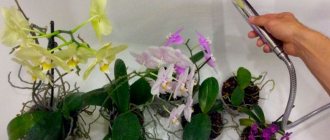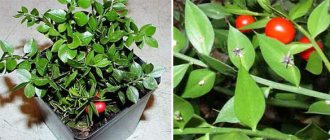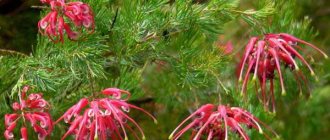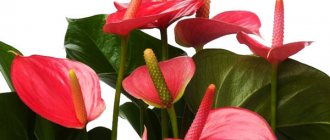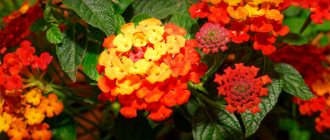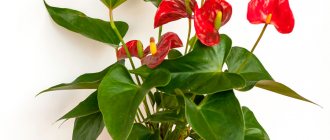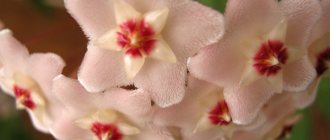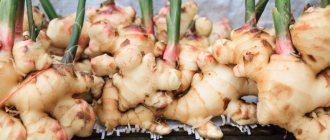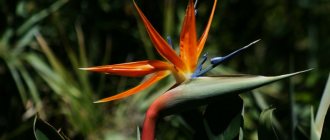Jugs
The flower of the “female” type has a more convex base and its appearance somewhat resembles a small jug. The edges of the “neck” of the jug are decorated with triangular dense teeth, which turn into a crown on an adult fruit. The pistils of the “female” flower are quite long and are located at or above the stamens.
Such inflorescences do not form on young shoots less than one year old. The ovary of the bud consists of several nests, which, when the fruit ripens, are filled with grains.
Areas of use
Pomegranate flowers contain many useful substances, which is why they are used to make healing tea . This drink perfectly refreshes and tones the body, and also has pronounced anti-inflammatory properties, which allows it to be used to treat sore throat, pharyngitis, stomatitis, inflammation of the joints, liver, kidneys, hearing and vision.
To prepare pomegranate tea, you will need to pour 1 teaspoon of flowers and buds with 250 ml of boiling water and let it brew for 15-20 minutes. In taste and color, this drink is a bit like hibiscus, which is made from hibiscus petals.
Pomegranate flowers are also used for cosmetic purposes. Tonics made on their basis improve the condition of aging, problematic, oily skin . And rinses enhance hair growth, give it shine and a well-groomed, healthy appearance.
Bells
The buds of “male” inflorescences, unlike “female” ones, have a narrower part at the base and a wider part at the end. Thanks to this, their appearance resembles bells.
The pistils of these cute bells are short and hidden inside the anthers. Such inflorescences most often appear on fresh branches of the current year and, after they bloom, simply fall from the tree.
The ratio of the total number of “male” and “female” inflorescences most often depends on a particular variety. Additionally, this point can be influenced by proper care and environmental conditions.
Baby
The appearance of the indoor pomegranate plant of the “Baby” variety resembles a bush. It grows up to 30–50 cm tall. The plant has noticeably 5–7 skeletal branches.
The foliage of this variety is elongated and arranged in even groups. The flowers are large in size (up to 7 cm), painted in a bright red hue. Sometimes the flowers are collected in groups, which enhances the decorative effect of the specimen.
This variety requires artificial pollination to produce fruit. For better ripening of pomegranates, it is recommended to remove excess ovaries.
Color spectrum
The color palette of a plant such as pomegranate is varied only in scarlet, crimson, pink and white shades. There are varieties of variegated inflorescences.
The shape of the flower can be so unusual and elegant that at first glance it is impossible to understand what kind of plant it is.
Pomegranate flowering time
A plant grown from a seed usually blooms after 3-4 years, for a pomegranate grown from a cutting - 2-3 years. Sometimes pomegranates bloom abnormally early, usually in this case only a few buds bloom and subsequently fall off.
Pomegranate, when grown at home, has two flowering periods. The first flowering occurs in April-May, the second in August. Despite the fact that one bud fades in 3-4 days, it is immediately replaced by another bud, and this continues until the end of the entire period.
Until autumn, the plant shines with flowers like garlands. It is especially interesting to watch the formation of buds, flowering and fruit formation - at such moments the pomegranate looks very luxurious and fabulous.
Average prices
There is a large selection of pomegranate fruit tree seedlings in nurseries and online stores .
Their prices vary from 250 rubles. up to 400 rub. for an annual plant and above. The lowest prices for pomegranate seedlings are in Crimean nurseries. The cost depends on the age of the plant, variety and pricing policy of the nursery. The cost of pomegranate fruits depends on the type of fruit, country of origin, supplier, and quality of the product. The price is also affected by the quantity of pomegranate purchased. Wholesale prices are much lower than retail prices. You can buy pomegranate wholesale (from 20 tons) for 85 rubles. for 1 kg. Online stores offer exotic fruit at prices starting from 300 rubles. up to 500 rub. per 1 kg.
Natural flower drop
As we already understood, pomegranate buds falling off during flowering is a normal phenomenon. In this regard, the plant itself determines how many flowers it can withstand, so that in the future it does not become depleted. This is a natural process not only for the common pomegranate, which grows outdoors, but also for a similar indoor plant, for example, such as the dwarf pomegranate.
Whatever the variety, if the tree bears fruit, then the falling off of the inflorescences is inevitable. And let us remind you that it is mainly “male” specimens that fall off - barren flowers.
How to choose?
Let's look at the difference between quality fruit:
- A quality fruit should be firm and dense.
- The crust should be dry and fit tightly around the grains.
- The outer color of the garnet should be uniform, the surface should be glossy, and there should be no dark spots present.
- If the fruits are heavy and dense, it means they are filled with juice.
- When lightly pressing on the fruit, you should hear the crunch of the grains.
- The top of a ripe pomegranate is topped with a “crown” - it should be open and dry, and the tail of a ripe fruit should not be green.
You can learn more about how to choose the right pomegranate from this material.
Diseases and pests
Heavier than natural flowering of pomegranate buds is usually a sign of plant disease.
The appearance of a white coating on pomegranate leaves is a sign of powdery mildew. Treatment can be carried out using Fundazol.
For gray rot (this disease is dangerous not only due to the falling of flowers, but also due to the drying out of the shoots), the antimicrobial fungicide Topsin M is used.
With the death of the main branches, ringing of the base of the shoots, cracking of the bark and general weakening of the plant, a diagnosis of Phomosis damage to pomegranate can be made. With this disease, the “female” inflorescences become infertile. You can treat using the fungicide Horus.
In addition to general diseases, a plant such as pomegranate very often suffers from insects.
Whiteflies love to attack leaves; they greedily attack them and suck out the juice. The insecticide Derris works well to kill this insect.
The pomegranate codling moth eats the juicy pulp of ovaries, inflorescences and fruits. This parasite is combated using Intra-vir and Fitoverm.
Nana
The height of this representative is 1 m, it is similar to a garden pomegranate, but its size is much smaller, the leaves are small, and the flowers and fruits are small.
Improper care
In addition to diseases and pests, pomegranate flowering often suffers from improper care.
Illiterate watering. This plant does not always need normal watering. Very often, during the flowering period, gardeners do not water it enough. But if you don’t delve into the essence of the matter, you can simply destroy the plant, which will not only begin a massive decline in flowers. The leaves will begin to fade and the tree will wither.
Spring frosts are also dangerous both for the tree and for future inflorescences. If a pomegranate survives such a nuisance, its flowering will either be postponed until next year, or it will be late and not abundant.
Insufficient lighting. Of course, the tree will grow in the shade, but without flowering, since it needs an eight-hour period of sunlight per day.
Incorrect tree pruning. The formation of the pomegranate crown must be done in late February - early March, when the plant has not yet fully awakened and there are no green shoots.
If you do this later and start cutting off green shoots with buds, the plant will only suffer and will take a very long time to recover! During the active growth period of the plant, only the shoots in the lower part of the trunk are cut off.
Insufficient air humidity. When the air is dry, the tree begins to wither. To increase moisture in the air, you can use spraying or place the container with the plant on a tray with wet expanded clay.
Pomegranate tree propagation
Pomegranate is propagated:
- seeds;
- bones;
- cuttings;
- vaccination.
Propagation using seeds
When propagating by seeds, it is necessary to take into account that only pomegranate species are suitable for taking planting material. The varieties do not retain the characteristics of the mother bush. Seeds are collected from a flowering tree or purchased in stores.
Planting is done as follows:
- The seeds are soaked for 24 hours in Kornevin.
- The planting material is dried and sown in a container with loose, breathable soil.
- The seedlings are covered with polyethylene or glass, and the container is placed in a bright place in the greenhouse. The seeds are ventilated daily.
- When the soil dries, it is sprayed with warm, settled water. The first shoots appear after two to three weeks.
- The shoots are planted in separate pots when three leaves appear on them.
Bushes grown from seeds bloom and produce crops only after five to eight years.
Propagation by seeds of indoor pomegranate
Reproduction using seeds
Seeds for cultivation are taken from large, ripened fruits. It’s not difficult to select them: they are cream-colored and hard. Green and soft seeds are not suitable for propagation. It is recommended to plant in April:
- The pulp is removed from the seeds, washed in cool water (possibly with potassium permanganate), and dried thoroughly. Thanks to this treatment, it is possible to avoid rotting, and the planting material remains viable for up to six months.
- Before planting, the seeds are soaked for half a day in a solution with two or three drops of Zircon or Epin. They should not be completely in water; they need oxygen.
- They are planted in the substrate to a depth of 0.5-1 centimeter in a pot with drainage.
- The container is placed in a warm place with good lighting. As the surface layer dries, the soil is moistened with warm, soft water.
- When two or three leaves appear on the seedlings, they are moved to permanent pots with a circumference of up to six centimeters.
- Shoots from ten centimeters, having three pairs of leaves, are pinched to improve branching.
With this method of cultivation, flowering is observed only after 6-9 years. In addition, the bush turns out to be large and may not fit into the size of the apartment.
Propagation by cuttings
This method is the most suitable for indoor growing due to the high percentage of germination and preservation of the varietal characteristics of the mother plant. When planting in summer, you need to take mature, semi-lignified shoots 10-15 cm long, with four to five buds. In winter, the same planting material is selected, but the germination rate decreases and rooting takes longer. Planting is done as follows:
- Cuttings are treated with Kornevin.
- The two lower buds are removed from the planting material.
- The shoots are placed in a loose nutrient substrate at an angle, 3 cm deep. Cover with film or glass. Ventilate, spray, and water as needed daily.
- Rooting occurs in two to three months. It must be taken into account that some of the shoots die. After complete rooting, the bushes can be replanted.
Flowering will begin next year. The pomegranate will bear fruit in two seasons.
Graft
A varietal cutting is grafted onto the rootstock. It is taken from a healthy fruit-bearing bush. Vaccination can be done in different ways. If the scion takes root, flowering will begin in three to four years.
